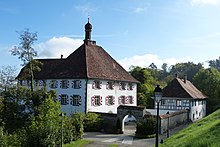Freudenfels Castle
Freudenfels Castle belongs to the municipality of Eschenz in the canton of Thurgau ( Switzerland ) and stands on a rock spur on the southern shore of the Untersee . It has been owned by Einsiedeln Abbey since 1623 and has been leased to the Liechtenstein Academy Foundation since 1996.
history
Freudenfels Castle was probably built in the 12th or 13th century by the Lords of Eschenz as a defense and residential tower on a rock spur one kilometer south-east of Eschenz . Together with the Hohenklingen and Oberstaad castles , this weir system served to secure the traffic junction near Stein am Rhein . At the same time, the jurisdiction of the same name was administered from here .
Freudenfels Castle was first mentioned in 1359 when the Lords of Hohenklingen passed to the Dukes of Austria . The medieval defense tower was rebuilt in 1617 and a residential wing was added.
After numerous changes of ownership, Freudenfels Castle and Lordship came into the possession of the Einsiedeln Monastery in 1623 , which united them with the Einsiedeln Office of Eschenz to form the Freudenfels-Eschenz judicial authority. The acquisition was made at the instigation of Augustin Hofmann (1556–1629), prince abbot of the Einsiedeln monastery, and the Swiss Benedictine congregation , which wanted to promote the re-Catholicization of the area. The jurisdiction of Freudenfels-Eschenz comprised roughly the area of today's municipality of Eschenz and goods in Kaltenbach , Wagenhausen and Nussbaumen . Freudenfels Castle was the seat of hermit governor since the acquisition from 1623 to 1985 and from 1730 to 1922 also the residence of the Catholic parish priest of Eschenz, a hermit priest .
From 1692 the complex was renovated by the architect and hermit lay brother Caspar Moosbrugger (1656–1723). In 1747 the hermit Abbot Nicolaus Imfeld commissioned the builder Frank Singer (1701–1757) with the baroque redesign of the Freudenfels Castle, which received its current appearance and from then on also served as the summer residence of the monks of the Einsiedeln monastery.
In the course of the Helvetic (1798–1803) the Freudenfels-Eschenz lordship lost its judicial privileges and gradually melted into what it is today: a palace complex and a farm, but both are still owned by Einsiedeln.
In 1988, Freudenfels Castle and its outbuildings were leased to the construction company Marti Holding AG , which converted the facility from 1989 to 1992 into a training facility. Since 1996 the leaseholder has been "Schloss Freudenfels AG", which is owned by the Princely House of Liechtenstein through the "Liechtenstein Academy Foundation" and uses the castle as a venue for parties and seminars.
Surroundings
- The Klingenzell pilgrimage church , which was consecrated to Our Lady of Sorrows in 1705, is located about 800 meters east of Freudenfels Castle, also elevated on the south bank of the Untersee .
- Less than a kilometer southeast of Freudenfels Castle is a former high watch which belonged to Hohenklingen Castle and served as border security and fire watch. In the 1930s, the artillery observation there was bunker A 5600 ⊙ the Swiss border fortification .
See also
literature
- Tobias Engelsing, Anne-Kathrin Reene: Schlösser am See - castles and country estates on western Lake Constance. 3. Edition. Südverlag, Konstanz 2015, ISBN 978-3-87800-062-4 , pp. 98f.
- Ernst Leisi : On the history of Freudenfels. In: Thurgauian contributions to patriotic history. Volume 61, 1924, pp. 32-35.
- Society for Swiss Art History (ed.): Art guide through Switzerland , Volume 1, Printed by Stämpfli AG, Bern 2005, ISBN 3-906131-95-5 , p. 689.
- Michael Losse , Ilga Koch: Palaces and fortresses on western Lake Constance. (= Hegau Library. Volume 122). Wartberg Verlag, Gudensberg-Gleichen 2004, ISBN 3-8313-1448-9 , p. 22f.
Web links
- Homepage of Freudenfels Castle
- Entry on Freudenfels Castle on www.swisscastles.ch
- Michel Guisolan: Freudenfels (TG). In: Historical Lexicon of Switzerland .
Coordinates: 47 ° 38 '20.4 " N , 8 ° 53' 20.2" E ; CH1903: seven hundred and eight thousand nine hundred and eighty-six / 277488


